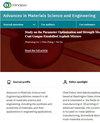B4C 增强 AA5083 金属基复合材料摩擦搅拌焊中摩擦系数的影响及使用模糊聚类技术预测焊接强度
4区 材料科学
Q2 Engineering
引用次数: 0
摘要
本研究采用搅拌摩擦焊(FSW)方法焊接 B4C 增强 AA 5083 金属基复合材料。通过对氮化钛 (TiN)、氮化铝铬 (AlCrN) 和类金刚石碳 (DLC) 进行厚度为 4 微米的涂层,开发出了三种具有方形针形轮廓的 FSW 工具,并保持了 0.69、0.32 和 0.2 的摩擦系数。在三个级别上,对工具旋转速度、横向进给和轴向力等工艺因素进行了检验。采用中心复合设计法为每种刀具制作了 15 个样本。研究了摩擦系数对极限拉伸强度、微观结构特征和工具条件的影响,并使用花粉授粉算法(FPA)技术找到了获得 FSW 接头最大极限拉伸强度的最佳工艺参数。通过验证试验验证了 FSW 接头抗拉强度的提高。根据工具摩擦系数的结果,涂层对极限拉伸强度、微观结构和工具状态有相当大的影响。使用模糊聚类技术预测强度的结果表明,该技术能有效预测拉伸强度值,TiN、AlCrN 和 DLC 的均方根误差(RSME)分别为 0.0027、0.0016 和 0.0015,较低的 RSME 表明基于模糊减法聚类技术的预测是完美和有效的。本文章由计算机程序翻译,如有差异,请以英文原文为准。
Effect of Friction Coefficient in Friction Stir Welding of B4C Reinforced AA5083 Metal Matrix Composites and Use of Fuzzy Clustering Technique for Weld Strength Prediction
The friction stir welding (FSW) method was used to weld B4C reinforced AA 5083 metal matrix composites in this study. By coating titanium nitride (TiN), aluminium chromium nitride (AlCrN), and diamond-like carbon (DLC) to a thickness of 4 microns, three FSW tools with square pin profiles were developed and the friction coefficients of 0.69, 0.32, and 0.2 were maintained. At three levels, the process factors such as tool rotating speed, transverse feed, and axial force were examined. For each tool, 15 samples were made using the central composite design. The influence of the friction coefficient on ultimate tensile strength, microstructural features, and tool condition was studied, and the flower pollination algorithm (FPA) technique was used to find the best process parameters for obtaining maximum ultimate tensile strength of FSW joints. The improved tensile strength of FSW joints was verified using a validation test. The coating has a considerable influence on the ultimate tensile strength, microstructure, and tool condition, according to the results of the tool’s friction coefficient. The results on the prediction of strength using the fuzzy clustering technique showed that the technique is effective in predicting the tensile strength values, with the root mean square error (RSME) of TiN, AlCrN, and DLC being 0.0027, 0.0016, and 0.0015, respectively, and the low RSME indicating that the prediction based on the fuzzy subtractive clustering technique is perfect and effective.
求助全文
通过发布文献求助,成功后即可免费获取论文全文。
去求助
来源期刊

Advances in Materials Science and Engineering
Materials Science-General Materials Science
CiteScore
3.30
自引率
0.00%
发文量
0
审稿时长
4-8 weeks
期刊介绍:
Advances in Materials Science and Engineering is a broad scope journal that publishes articles in all areas of materials science and engineering including, but not limited to:
-Chemistry and fundamental properties of matter
-Material synthesis, fabrication, manufacture, and processing
-Magnetic, electrical, thermal, and optical properties of materials
-Strength, durability, and mechanical behaviour of materials
-Consideration of materials in structural design, modelling, and engineering
-Green and renewable materials, and consideration of materials’ life cycles
-Materials in specialist applications (such as medicine, energy, aerospace, and nanotechnology)
 求助内容:
求助内容: 应助结果提醒方式:
应助结果提醒方式:


